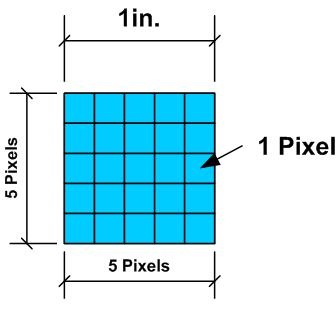Image resolution - the deciding factor for fine print
When it comes to image correction, resolution is one of the most important concepts to master to print pictures that look good.
This article will help you find out what resolution really is, when you need to care about resolution, and how to incorporate these concepts into your final printed image.
To understand all about the resolution, we'll start by scrutinizing our digital photos to see what they include.
Pixel definition and resolution
Open a picture in the image editor you have selected and zoom in with the Zoom or Magnify tool (in both Photoshop and Photoshop Elements, on a Mac you can hold down the Command key and the + key repeatedly to zoom in) . Soon, you will see colored squares. These blocks are called pixels, and all of these pixels form the image you see on the screen. Depending on the quality setting of your digital camera, the image may have several hundred or several thousand pixels in width and length.
The pixel has no predefined size - it can be very small or very large. The calculation that governs the size of the pixel is called the resolution. Indeed, the quality setting on your digital camera determines how many pixels to capture when you press the shutter close button, but does anyone know how big these pixels are? Before you send the command to print these images to the printer, you need to make sure that these pixels are small enough so that the naked eye cannot see them.
In the field of photo printing, the resolution calculated by dpi (dots per inch) is the number of points on a 1-inch square area, which is understandable because most printers print into points. For on-screen images - of computers, TVs, plasma, or projectors - the resolution is calculated in ppi (pixels per inch).
Impact between pixels and resolution
 Resolution dictates the size of the pixel (pixel) by determining how many pixels are clustered in the same place (considered pixel density). When you increase the image resolution, the pixel will be smaller so that more pixels can be collected. As a result, the physical print size will be smaller because these smaller pixels occupy less area than large pixels, although smaller pixels will produce high quality smooth prints. Low resolution images with fewer pixels are gathered in one place, which allows them to be larger in size. As a result, the physical print size will be larger (larger pixels take up more space), the printed image looks like it is made with Lego puzzle pieces because the pixels are so big that you can see each pixel. .
Resolution dictates the size of the pixel (pixel) by determining how many pixels are clustered in the same place (considered pixel density). When you increase the image resolution, the pixel will be smaller so that more pixels can be collected. As a result, the physical print size will be smaller because these smaller pixels occupy less area than large pixels, although smaller pixels will produce high quality smooth prints. Low resolution images with fewer pixels are gathered in one place, which allows them to be larger in size. As a result, the physical print size will be larger (larger pixels take up more space), the printed image looks like it is made with Lego puzzle pieces because the pixels are so big that you can see each pixel. .
This concept is easier to understand if it relates to reality. Suppose you are baking a cake. When you add brown sugar to the measuring cup (the measuring cup), the sugar can reach a full cup. But when you squeeze the sugar into the cup, the sugar is compressed to half a cup. You still have the same number of sugar grains (like the number of pixels); they are only compressed together within the same physical limit of the measuring cup (as your photo). The initial uncompressed sugars may be like low resolution, and compacted particles such as high resolution.
Resolution is only important when printing photos
 The printer is one of the few devices that can do anything with a resolution size. You can print low-resolution images (72 ppi) and high-resolution images (300 ppi), and you'll have different results: one print out every block and one smooth image. The display of computers, projectors, and other digital display devices, all different because of video drivers - software that controls what you see on the screen - is controlling the resolution to display. Therefore, a 72 ppi image looks exactly like a 600 ppi image. That's why the concept of resolution is so difficult to understand - you can't see the resolution changes on the screen.
The printer is one of the few devices that can do anything with a resolution size. You can print low-resolution images (72 ppi) and high-resolution images (300 ppi), and you'll have different results: one print out every block and one smooth image. The display of computers, projectors, and other digital display devices, all different because of video drivers - software that controls what you see on the screen - is controlling the resolution to display. Therefore, a 72 ppi image looks exactly like a 600 ppi image. That's why the concept of resolution is so difficult to understand - you can't see the resolution changes on the screen.
The truth is that resolution is only important when you bring your photos to print. If your photos are intended to be viewed on the screen - on a web page, in a presentation, or for a slide show - the resolution doesn't matter because the viewer can't see the difference between the resolutions with together.
You should read it
- Sony announces today's highest resolution image sensor for smartphones
- What is 16K resolution?
- Pixel and Pixel XL duo were killed by Google
- What is the difference between DPI, PPI, resolution and image size?
- What is Upscale TV? And how does it work?
- Google stops production of Pixel 5
- Instructions on how to increase the resolution for photos
- Google has just revealed the price of Pixel 4a and Pixel 5, surprisingly cheap
May be interested
- How to Run Chromebook Chromium OS on a Standard PC
 if you have a computer, one of the most important tasks is deciding which os to install on it, or if your os was oem installed, deciding to keep your preloaded os or to up/downgrade or change os completely. in this tutorial, you will learn...
if you have a computer, one of the most important tasks is deciding which os to install on it, or if your os was oem installed, deciding to keep your preloaded os or to up/downgrade or change os completely. in this tutorial, you will learn... - Sony announces today's highest resolution image sensor for smartphones
 the new imx586 image sensor for sony smartphones with resolutions up to 48 mp (8,000 x 6,000 pixels), the highest in the world today promises to bring a leap in image quality.
the new imx586 image sensor for sony smartphones with resolutions up to 48 mp (8,000 x 6,000 pixels), the highest in the world today promises to bring a leap in image quality. - How to Increase Photo Resolution on iPhone or iPad
 this article shows you how to increase photo and video resolution in your iphone or ipad camera. although there is no way to directly adjust image resolution, you can convert to jpeg format for the highest image quality.
this article shows you how to increase photo and video resolution in your iphone or ipad camera. although there is no way to directly adjust image resolution, you can convert to jpeg format for the highest image quality. - How to Print a Large Image on Multiple Pages on PC or Mac
 this wikihow teaches you how to print one large image on multiple sheets of paper (also known as a tiled or rasterbated poster) from your pc or mac. go to https://rasterbator.net/ in a web browser. the rasterbator is a popular website...
this wikihow teaches you how to print one large image on multiple sheets of paper (also known as a tiled or rasterbated poster) from your pc or mac. go to https://rasterbator.net/ in a web browser. the rasterbator is a popular website... - How to view image size (resolution) on iPhone
 every digital image stored on your iphone has a certain resolution, determined by the number of pixels in the photo.
every digital image stored on your iphone has a certain resolution, determined by the number of pixels in the photo. - Why does today's smartphone have a higher resolution than professional cameras and cheaper resale prices?
 so why do professional photographers spend a lot of money to buy bulky cameras without using smartphones to take pictures?
so why do professional photographers spend a lot of money to buy bulky cameras without using smartphones to take pictures? - Authenticate what two factors are and why you should use it
 two-factor authentication (2fa) is a security method that requires two different ways to prove your identity. it is often used in everyday life.
two-factor authentication (2fa) is a security method that requires two different ways to prove your identity. it is often used in everyday life. - Protect your GitHub account with two-factor authentication
 two-factor authentication helps keep your online accounts secure. therefore, increasing the security of your github account with two-factor authentication is a smart thing to do.
two-factor authentication helps keep your online accounts secure. therefore, increasing the security of your github account with two-factor authentication is a smart thing to do. - Relax with 3 ways to print in this simple reverse order
 there is always a right way to print your documents. some inkjet printers print pages from the top, which means you have to manually reverse the print order. this is not a problem when printing only a few pages, but when you print a few hundred pages of documents then you need a trick to print them in reverse order so you can arrange them neatly.
there is always a right way to print your documents. some inkjet printers print pages from the top, which means you have to manually reverse the print order. this is not a problem when printing only a few pages, but when you print a few hundred pages of documents then you need a trick to print them in reverse order so you can arrange them neatly. - Smartphone with up to 48MP resolution camera will be released next year thanks to new image sensor technology
 the isocell bright gm1 sensor duo has 48mp resolution and isocell bright gd1 has 32mp resolution but its size is only about 0.8 micrometers.
the isocell bright gm1 sensor duo has 48mp resolution and isocell bright gd1 has 32mp resolution but its size is only about 0.8 micrometers.










 New generation wireless initiatives
New generation wireless initiatives Interesting secret about 'social networks'
Interesting secret about 'social networks' Use laptop batteries most effectively
Use laptop batteries most effectively A list of 101 utility websites
A list of 101 utility websites Connect between Windows 7 and Linux using TightVNC
Connect between Windows 7 and Linux using TightVNC Introducing Wolfram Alpha search engine
Introducing Wolfram Alpha search engine